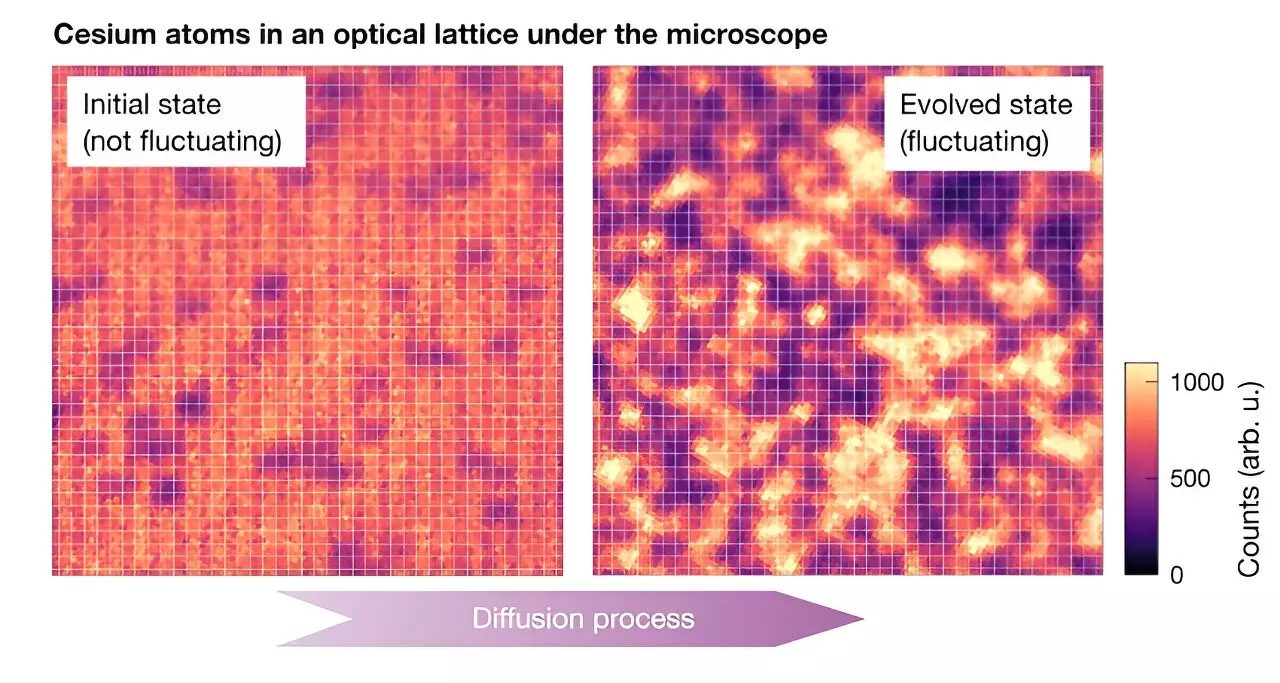In an era marked by rapid advancements in quantum physics, researchers from Ludwig-Maximilians-Universität, the Max-Planck Institute for Quantum Optics, the Munich Center for Quantum Science and Technology, and the University of Massachusetts have made significant strides in understanding equilibrium fluctuations within large quantum systems. Their groundbreaking study, recently published in *Nature Physics*, utilizes sophisticated quantum simulations facilitated by a quantum gas microscope—a revolutionary instrument designed to visualize and manipulate individual atoms in ultracold environments.
The core of the research revolves around a fundamental question in quantum mechanics: how can we accurately predict the evolution of a large collection of particles? As co-author Julian Wienand elucidates, despite a comprehensive understanding of the underlying physics, the sheer number of particles poses formidable challenges for traditional computational methods. Classical simulations might falter under the computational load due to complex interactions and dependencies among numerous particles. Consequently, the researchers proposed leveraging hydrodynamics theory as a viable alternative to circumvent these computational constraints.
Hydrodynamics: An Ingenious Solution
Hydrodynamics serves as a powerful framework for simulating the collective behavior of particles within chaotic systems. When a system is chaotic, researchers can assume that particles interact in ways that promote local thermal equilibrium, allowing the use of macroscopic parameters to describe what is fundamentally a microscopic phenomenon. Wienand explains that this macroscopic description simplifies the complexities of particle behavior into a manageable continuous density field governed by simple differential equations.
However, a unique characteristic of such systems is that fluctuations occur; these rapid changes in particle density can be treated as random noise. By incorporating these fluctuations into hydrodynamic equations, scientists are able to develop the concept of fluctuating hydrodynamics (FHD). This extension not only accounts for classical physical processes but also enriches the theory by incorporating thermal fluctuations, thereby offering a comprehensive approach to understanding the dynamics of complex quantum systems.
The researchers conducted their experiments using a cesium (Cs) quantum gas microscope, where they trapped ultracold cesium atoms within an optical lattice—a structure formed by laser light that defines the arrangement of particles. This method allowed for unprecedented single-site resolution, enabling precise observation of particle occupations within a lattice framework. By meticulously arranging the particles into a distinct pattern and subsequently altering the lattice’s depths, the team facilitated a diffusion process among the Cs atoms, essentially allowing them to interact freely and thermalize.
This setup was pivotal for tracking the dynamic evolution of fluctuations, as it allowed researchers to relate theoretically predicted growth rates of these fluctuations with empirical data from their observations. Analyzing this interplay, the research team effectively demonstrated that FHD could quantitatively and qualitatively describe the behavior of chaotic quantum systems, a finding that holds broad implications for theoretical physics.
Wienand’s work indicates that macroscopic behaviors in quantum systems can be described through simplified models of classical diffusion, largely governed by the diffusion constant—a parameter that encapsulates critical information about the system’s dynamics. Notably, the concept that simplistic models can represent complex quantum behaviors challenges long-standing assumptions about the distinctions between classical and quantum physics.
The study denotes a significant leap in advancing our grasp of fluctuating hydrodynamics as it relates to chaotic quantum systems. The researchers’ insight suggests that even amid intricate quantum interactions, there exists an underlying simplicity in macroscopic behaviors—a revelation that may bridge a crucial gap in our understanding of how quantum systems operate on larger scales.
Looking forward, Wienand and his colleagues are eager to further explore the principles of fluctuating hydrodynamics via their quantum gas microscope. They are poised to investigate new questions, such as the behavior of fluctuations in systems that resist thermalization and the potential adaptation of FHD to accommodate more convoluted observables or exotic systems. These pursuits are set against a backdrop of ever-evolving challenges that both excite and bedevil the field of quantum physics as researchers strive to unravel its complexities.
This pioneering research not only sheds light on the behaviors of chaotic quantum systems but also reinforces the interconnectedness of macroscopic and microscopic theories. The ability to employ hydrodynamic principles to elucidate quantum mechanics marks a new chapter in theoretical and experimental exploration, with potential applications across diverse areas, including quantum computing and material science. As these researchers continue to probe the intricate dance of particles within the quantum realm, their findings promise to deepen our understanding of a universe governed by the fundamental laws of physics.


Leave a Reply